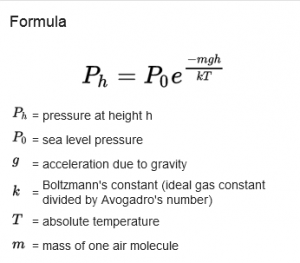
Atmospheric pressure is the force exerted on a surface by the weight of air above that surface. The total atmospheric pressure at sea level is the average of the air pressure at the Earth’s surface and the air pressure at sea level.
The atmospheric pressure is expressed in units of milibar. At sea level the average atmospheric pressure is 1,013.2 milibar. Due to gravity, the air at the surface is denser and hence has higher pressure.
Air pressure is measured with the help of a mercury barometer or the aneroid barometer. The pressure decreases with height.
In most circumstances, atmospheric pressure is closely approximated by the hydrostatic pressure caused by the weight of air above the measurement point.
As elevation increases, there is less overlying atmospheric mass, so that atmospheric pressure decreases with increasing elevation.
Because the atmosphere is thin relative to the Earth’s radius—especially the dense atmospheric layer at low altitudes—the Earth’s gravitational acceleration as a function of altitude can be approximated as constant and contributes little to this fall off.

Pressure measures force per unit area, with SI units of pascals (1 pascal = 1 newton per square metre, 1 N/m2).
On average, a column of air with a cross-sectional area of 1 square centimetre (cm2), measured from mean (average) sea level to the top of Earth’s atmosphere, has a mass of about 1.03 kilogram and exerts a force or “weight” of about 10.1 newtons, resulting in a pressure of 10.1 N/cm2 or 101 kN/m2 (101 kilopascals, kPa).
A column of air with a cross-sectional area of 1 in2 would have a weight of about 14.7 lbf, resulting in a pressure of 14.7 lbf/in2.
Vertical Variation of Pressure
Variations in the vertical profile of atmospheric pressure are produced by the expansion and contraction of the atmosphere due to diurnal warming and cooling, convergence and divergence (convergence at low levels due to heating, for example by the Sun’s rays, divergence at higher levels as a result of increasing height where lower temperatures prevail), gravity waves, instability waves, orographic effects, and other influences called vertical circulations.
In the lower atmosphere the pressure decreases rapidly with height. The decrease amounts to about 1 mb for each 10 m increase in elevation. It does not always decrease at the same rate.
Horizontal Distribution of Pressure
Wind blowing across the weather deck of a tall ship, for example, exerts more force at deck level than it does higher up. One reason that topsails are carried is to compensate the pressure distribution.
The physical principle underlying this is that pressure (P) exerted by fluid moving uniformly across any surface is directly proportional to the area (A) covered by the fluid divided by the speed (V) at which the fluid moves.
Horizontal distribution of pressure is studied by drawing isobars at constant levels. Isobars are lines connecting places having equal pressure. In order to eliminate the effect of altitude on pressure, it is measured at any station after being reduced to sea level for purposes of comparison.

